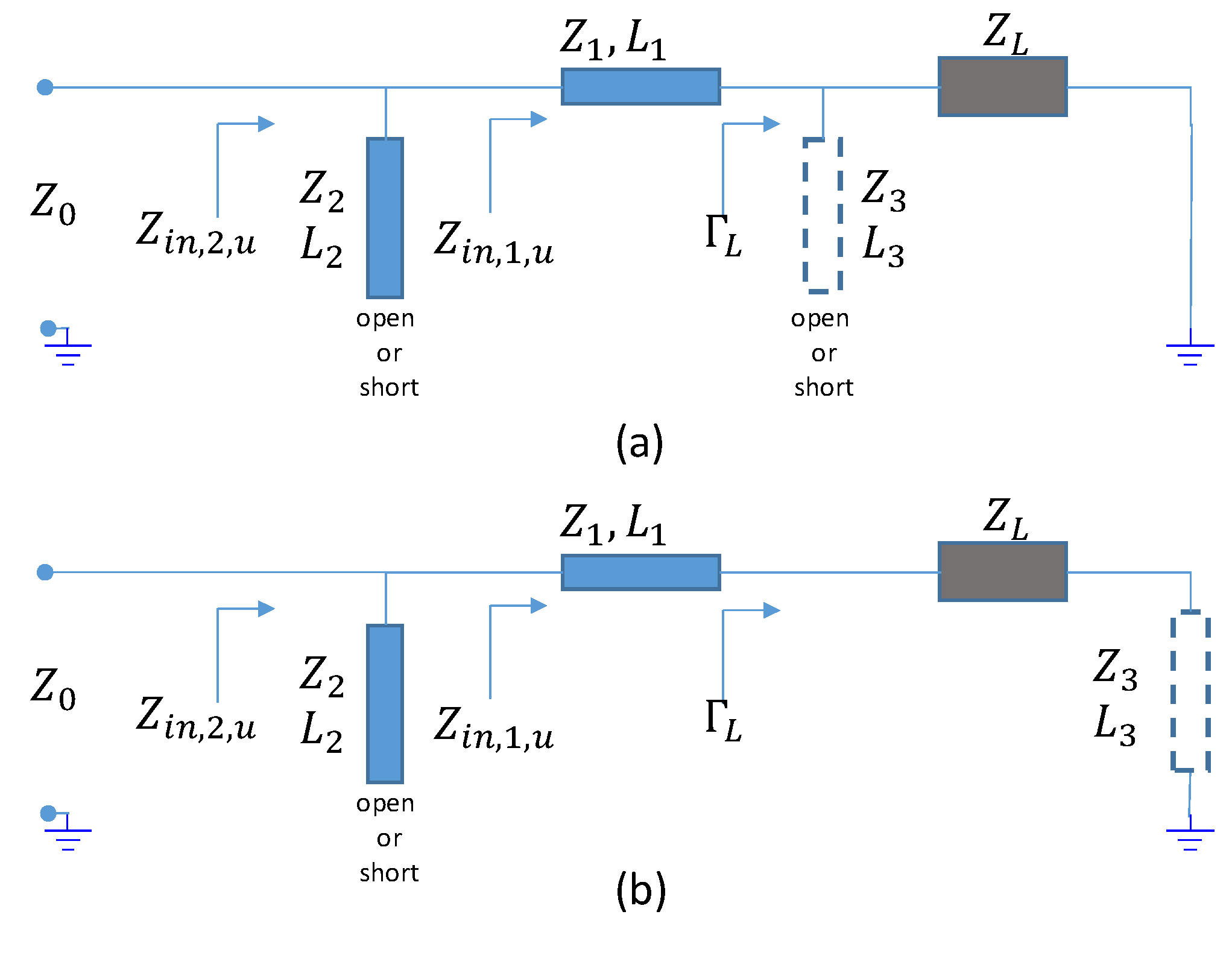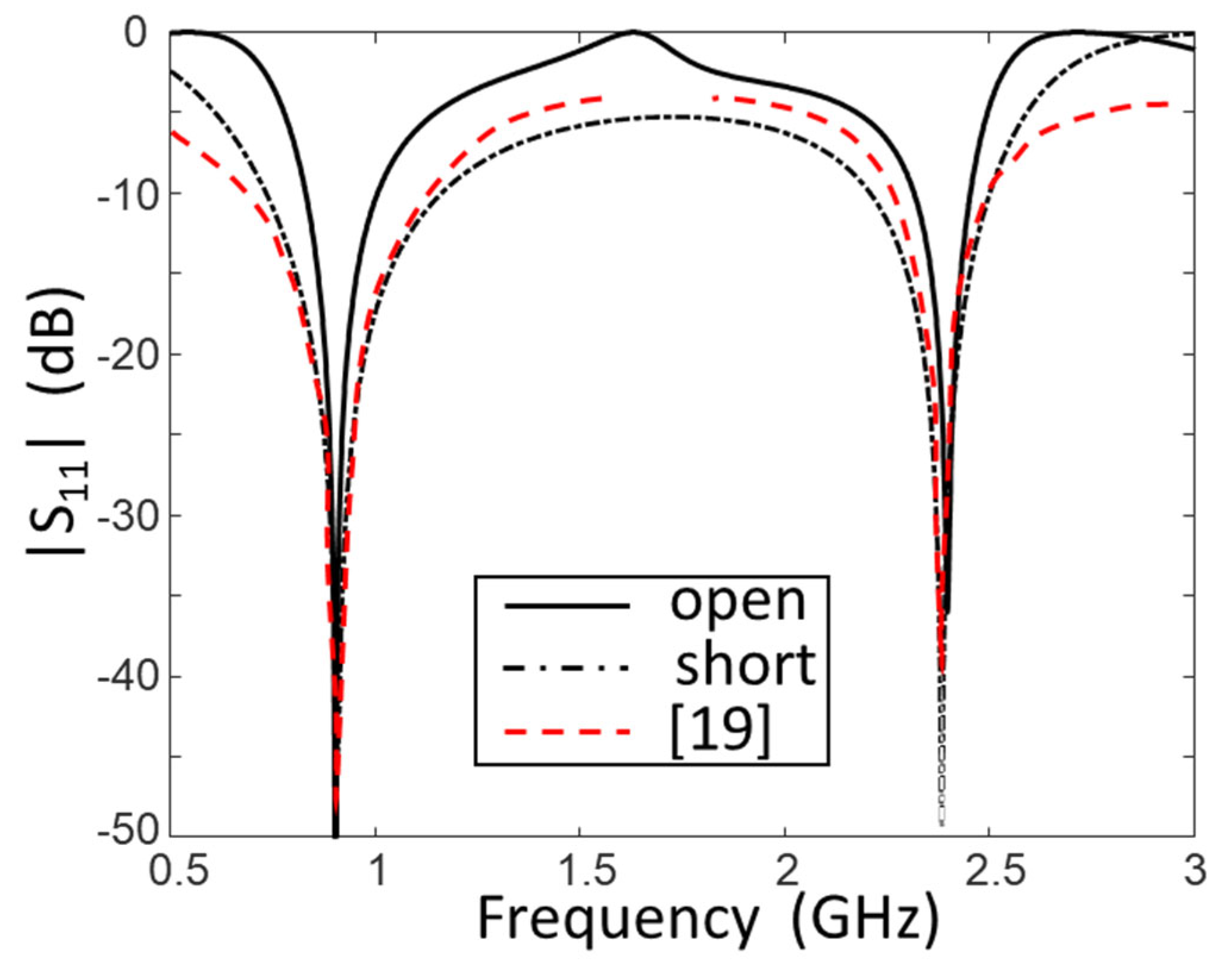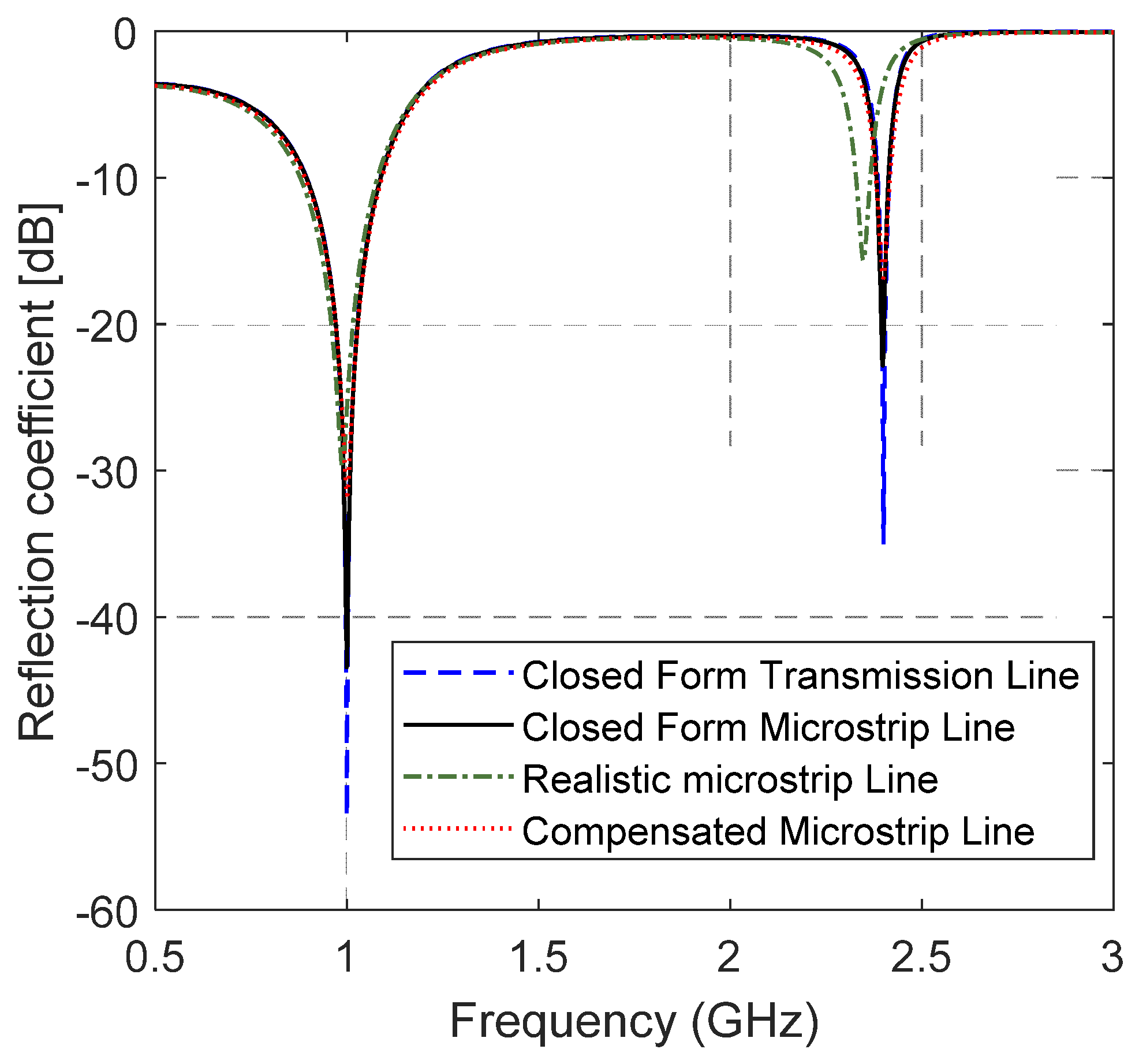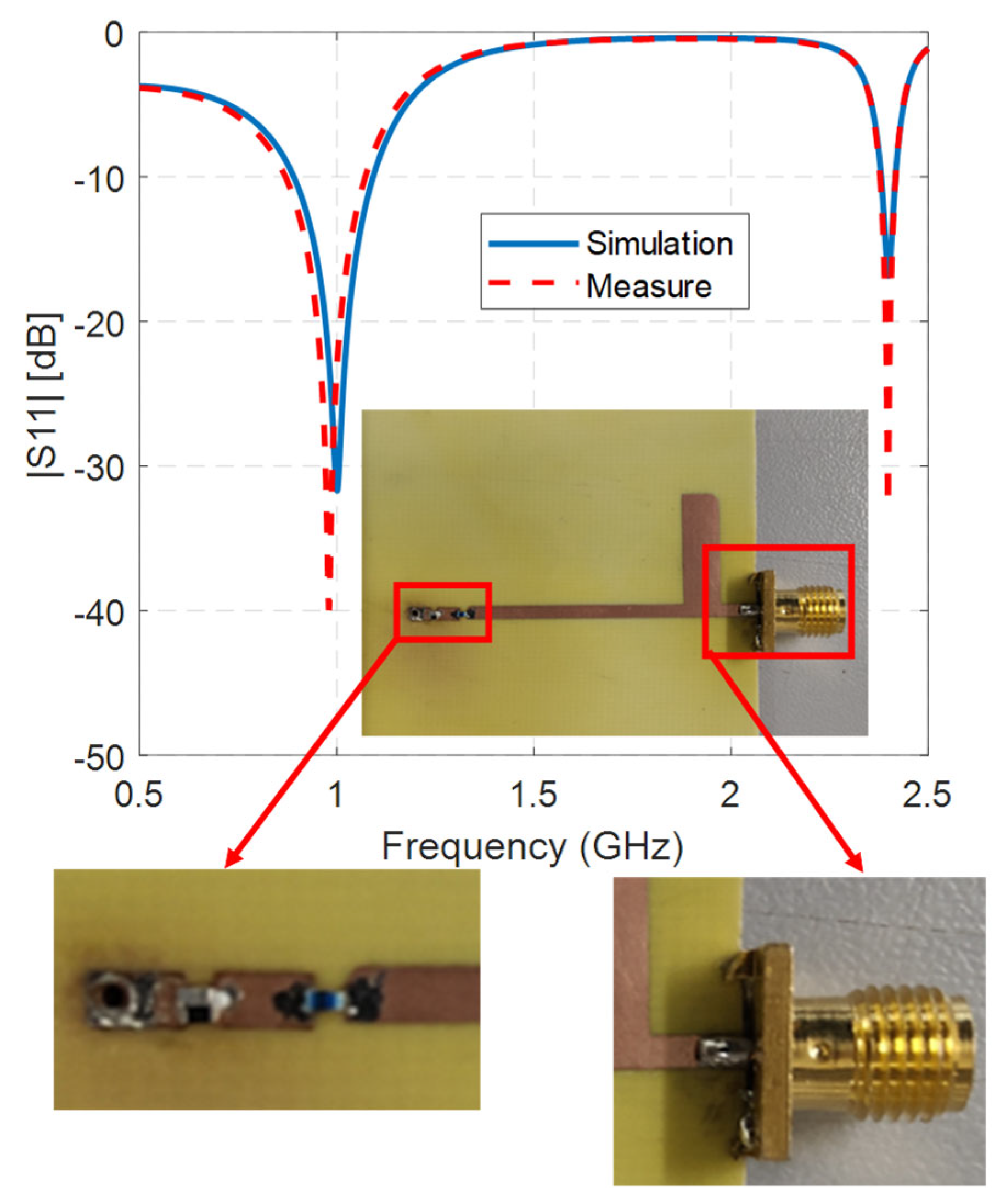1. Introduction
There are a number of applications in communication systems that require working at multiple frequencies concurrently. In particular, there are applications such as radio frequency identification [
1], harmonic radar [
2], power amplifiers [
3], and power dividers [
4] that work at two frequencies, which require the development of dual band matching networks. There are also several works in the literature that face the problem of dual band matching networks, which can be grouped in methods for real loads and methods for complex loads. In the case of real loads, dual frequency transformers [
5,
6] perform the matching between a resistive load and a transmission line at the fundamental frequency and its first harmonic, [
7] extends the method to two arbitrary frequencies while [
8,
9] solve that problem using the Chebyshev impedance transformer. A dual band stubbed T-junction was shown in [
10], a multi-section transformer was proposed in [
11] while a π-network was shown in [
12]. Concerning methods for complex loads, [
13] faced the problem in the case of complex conjugated loads while [
14,
15,
16,
17] addressed the complex impedance matching problem by resorting to an unequal two-section and a three-section impedance transformer, respectively. Nevertheless, the results shown have unfeasible characteristic impedances. A T-section impedance transformer was proposed in [
18], while [
19] used two-parts with two-section shunt stubs that permit the choice of the characteristic impedances of transmission lines. A π-network is frequently used in the simple form [
20] and with additional shunt stubs [
21], while a similar structure was recently proposed in [
22,
23] and in [
24] that, instead, used a cascade of filters and phase shifters.
The mentioned methods were based on matching networks with predefined topologies, some of them adequately solve specific matching problems (i.e., for specific loads), while others, which have been proposed to be more general, provide, for particular loads, the characteristic impedance of the lines that cannot be realized. As an example, [
25] showed that for a given set of complex load impedances, the T-section impedance transformer proposed in [
18] calculated unfeasible characteristic impedances. To overcome this limit, it proposed increasing the complexity of the network by including an additional section called ‘load healing’. The increase in the number of elements of the network is often a redundant operation since it increases the degrees of freedom of a problem that only has four constraints. The availability of several degrees of freedom can be exploited to add constraints to the network system, for example, [
19] imposed the choice of characteristic impedances using a network with four sections while [
26], with a five-section network, imposed the rejection of a frequency besides the dual band matching.
It is clear that to solve the same kind of problem, methods involving very different network topologies with a different number of sections have been proposed, however, to the best of our knowledge, no one has proposed solving this type of problem by using a network with only two sections. From a mathematical point of view, two sections should be sufficient for this type of problem as they give four degrees of freedom (i.e., as many as the constraints). On the other hand, in an N-section network, the solution has to be found in a 2N dimensional space where the best solutions are hidden among many other suboptimal ones. It would be better to keep the dimension of the space the smallest possible in order to have easier solutions and simpler networks. It is evident that the equations to be solved are non-linear and transcendental, therefore four degrees of freedom may not be sufficient in particular situations, but for the same reason, for other loads, they could give a number of solutions greater than one.
We propose a new resolution method of the closed form equations of the dual band matching network problem for complex loads and any couple of frequencies that give solutions with the minimum number of sections (i.e., two at most three). We also show that most of the complex loads in the literature that have been matched with networks having more than three sections can be adequately matched with networks having only two sections. The method resorts only to transmission lines and is able to find multiple solutions within a predefined range of permissible characteristic impedances for the elements of the network.
The rest of this paper is organized as follows.
Section 2 shows the closed form equations and the proposed resolution method, and
Section 3 reports on the simulative and experimental results.
2. Matching Procedure
The topology of the network is modular and originates from the observation that two sections of a transmission line have four degrees of freedom, which would be sufficient to match a complex load to a transmission line with assigned characteristic impedance at two different frequencies. Nevertheless, there are particular loads for which that procedure is not able to exploit the four degrees of freedom adequately, so it is necessary to introduce a third line element.
The procedure consists of three steps. The first step determines the parameters of the main transmission line ((
,
) in
Figure 1) connected to the load so that it brings the real part of the admittances (at the two frequencies) at its input port to coincide with the value of the desired matching admittance. For particular loads, the first step may not give a solution, in this case, a third line element ((
,
) in
Figure 1) is introduced, which modifies the load impedance seen from the main transmission line and allows obtain a solution repeating the first step to be obtained. The last step adds a stub ((
,
) in
Figure 1), which can be open or short, and it makes null the two susceptances (at the two frequencies) at the input port of the main transmission line. The procedure can be repeated recursively by changing some parameters, as shown in the next section, in order to tune the design parameters to the specification values. The method is intrinsically narrowband, making use of a few elements.
We consider a load
that has different impedances at two different frequencies. The envisaged matching network, shown in
Figure 1, consists of two actual line elements with different characteristic impedance and length (blue colored) and a possible third line element (dashed contour) to be added in case the actual line elements are not sufficient to achieve the matching of the load to the characteristic impedance
.
Let , , and , be the characteristic impedances and the lengths, respectively, of the actual lines, these are unknowns to be determined to perform the matching.
Let and be the complex impedances of the load at frequency and , respectively, and , .
The reflection coefficient at the load is
that has magnitude
and phase
where
denotes one of the two frequencies [
27].
The admittance at the input of the first line is
where
and
is the electric length of the line (i.e.,
with
the propagation constant at the frequency specified by index
) [
27].
The corresponding conductance is
We infer that for each in order to have a couple of equations to determine the unknowns and , which satisfy the first step of the matching procedure.
Equations are
with
.
Since
is a function of
and
is a function of
, these equations represent two curves (i.e.,
, over the plane (
,
); they may intersect at some points that are solutions to the system (4). From the first equation, we find
that depends only on
and has to undergo the constraints
and
being representative of a physical line in the interval of
that we were interested in considering. In practice,
has to span over an interval of values that permits the practical feasibility of the line.
Since
(assuming the line not dispersive), we can exploit the second equation of (4) to have
that permits us to find the values of
solutions to the system (4) after including (5) in (8). This equation can be solved numerically by imposing constraints (6) and (7).
In general, there are four solutions to system (4) since (8) gives two solutions for each solution of (5) but may be cases of
for which no solution is available from (8). In this case, we introduce a further line element in order to obtain a solution. This is described and discussed in
Section 2.1.
Once and have been obtained, we determine and by dimensioning a suitable stub that makes null the imaginary parts of . We considered both open and short circuit stub cases.
Let
be the imaginary part of
; in the case of an open circuit stub, we have to solve the system
which gives
and
In the case of a short circuit stub, the solution is given by
and
Equations (10)–(13) give, in general, more solutions, but some of them may have and are discarded.
Nevertheless, there are cases where
where (11) and (13) do not have a solution.
Since the ratio depends on the solution of (4), which in general has more than one solution, it is possible to find a particular solution of (4) that does not satisfy (14). In the case this is not possible, we introduced a third element in the matching network, as shown in the next subsection.
2.1. Third Line Elements
If the network made with two transmission line elements did not allow the matching, we introduced a third line element, as shown in
Figure 1. This element can be placed in front of the load as a stub (open or short) (
Figure 1a) or alternatively in series to connect the load to the ground (
Figure 1b). The choice of the topology of that third element is arbitrary and alternative (i.e., if a choice does not lead to a satisfactory matching network, we can change the topology). Since we did not have any constraint to impose on the additional transmission line, we arbitrarily chose the characteristic impedance
and optimized the length
in order to have satisfactory values of
and
for the practical feasibility of the corresponding transmission lines.
The algorithm first calculates the electrical length
(i.e., at frequency
) that makes null the imaginary part of the impedance of the combination of that third element with the load at frequency
. Let
be the susceptance of the load at frequency
and
a tuning parameter to be varied arbitrarily, so we have three different results for the three alternative lines:
in the case of an open circuit stub;
in the case of a short circuit stub; and
in the case of a transmission line connecting the load to the ground.
Once and have been determined, the algorithm restarts from (1), calculating the reflection coefficient and repeats the procedure. After a solution is obtained, can be tuned repeating cyclically the procedure by varying and in order to achieve the values of , and , as close as possible the specification values.
In general, the above described procedure provides more solutions that permit for the matching of the load using transmission lines with characteristic impedance inside an assigned interval.
3. Numerical Results and Experimental
The proposed procedure was validated numerically and experimentally. For the assigned values of the load at two specific frequencies, the procedure searched the possible matching networks under the constraint that the characteristic impedance of the lines was inside the interval
. Extensive numerical analysis was performed by means of an ad-hoc made program written in MATLAB [
28], checking the behavior of the found matching networks for a large number of loads. The check was based on the analysis of the found solutions by means of Cadence AWR-DE [
29] to verify that the reflection coefficient (
) at the input port of the network had two matching deeps at the assigned frequencies. It has been found that most loads can be matched with only two line elements (i.e.,
and
) while the third element is necessary mainly when the load at the two frequencies is nearby the open circuit point of the Smith chart.
Table 1 reports some examples of matching results: the first column shows the complex impedance of the load at the two frequencies (in GHz) shown in column 2, the other columns show the characteristic impedance and the electric length (in degrees) @
of the elements of the matching network. We observed that multiple solutions were possible, some cases required three elements in the matching network, and in any case, the characteristic impedance of the lines was inside the predefined interval. Considering, as an example, the first case shown in
Table 1 (i.e.,
,
), the proposed procedure found seven different matching networks able to match that load; the graphs of the reflection coefficient obtained with the numerical check are shown in
Figure 2. Some solutions were very narrow band and the reflection coefficient was flat outside the band while others instead had a bandwidth that was a little bit larger but showed a ripple of the reflection coefficient outside the matching band.
The loads in the first column of
Table 1 that have the symbol of reference were taken from the literature. All of them, in the corresponding papers, were matched with networks having a number of sections greater than or equal to three. With this method, we propose that they are matched with only two sections except for one, which requires three; moreover, it was observed that there were multiple solutions.
In order to check the effectiveness of the matching with two sections with respect to that obtained in the literature with several sections, we show in
Figure 3 and
Figure 4 the comparison between the reflection coefficients of two cases realized in [
19,
20]. The matching bandwidths at
in
Figure 3 (black line) were
and
in the case of open stub while they were
and
in the case of the stub in short. In
Figure 4, instead, the matching bandwidths were
and
. It is evident that the results obtained with the two-section networks were as adequate as those shown in the literature.
The experimental validation consisted of the realization and measurement of a matching network corresponding to the third case in
Table 1. The load was made with a lumped circuit with
resistance in parallel to a
capacitance with a
inductance in series, as shown in
Figure 5a, where the names of the used components are also shown. The model of the load accounts for pads and via-hole that are used to realize the circuit so that the input impedance of the overall load circuit is
and
.
At least eight two-section matching networks were possible for that load and we realized the first one shown in
Table 1 (i.e.,
) that had an open stub. The overall circuit was realized with microstrip lines over the
R4003C substrate having a thickness of 0.81 mm,
. Evidently, the calculated parameters of the matching transmission lines do not take into account the parasitic effects that arise in a real microstrip line circuit because of the discontinuities such as the end effect of the open stub and the reactances introduced by the T-junction. A simulative comparison of the reflection coefficients of different models of the matching network is shown in
Figure 6. The models are based on the schematics shown in
Figure 5b,c, they concern: (i) closed form solutions (
Figure 5b) and (ii) a realistic microstrip line (
Figure 5c). Closed form solutions make use of the found parameters in a lossless theoretical transmission line model and in a microstrip model that takes into account the losses of the substrate. As shown in
Figure 6, the corresponding reflection coefficients differed mainly for the depth of the matching hollows. In the realistic microstrip line model, we introduced the T-junction element and the end effect on the stub, preserving the lengths and the impedances of the lines. In this case, a shift toward lower frequency was observed
(dash-dotted green line in
Figure 6). Nevertheless, a simple compensation [
30] that slightly reduces the lengths of the lines (obtained values shown in
Figure 5c) permits the circuit to be exactly matched (dotted black line in
Figure 6). The compensated microstrip line circuit was realized and measured, and the obtained reflection coefficient, shown in
Figure 7, had good agreement with the simulation result. The matching bandwidths were
and 1.6
.
The prototype was realized using a milling and drilling machine T-Tech quick circuit 5000 while measurements were performed using a Vector Network Analyzer Anritsu MS46122B, calibrated with 5001 sample points inside the bandwidth of 0.5 GHz–2.5 GHz.



















